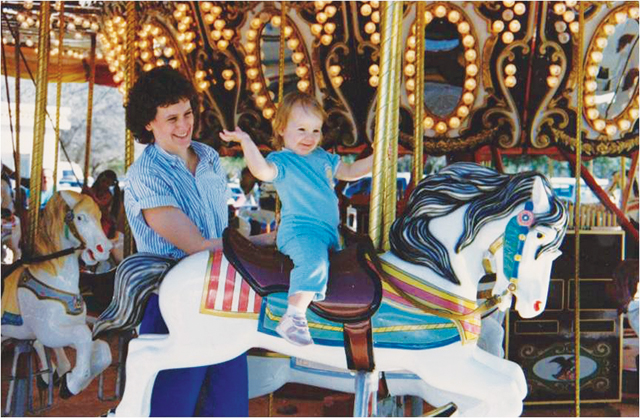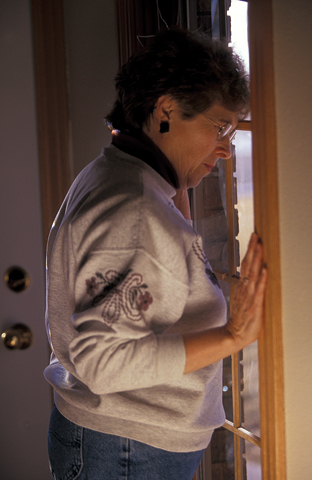15.2 Anxiety Disorders: When Fears Take Over
When is anxiety harmful, and when is it helpful?
“Okay, time for a pop quiz that will be half your grade for this class.” If your instructor had actually said that, you would probably have experienced a wave of anxiety and dread. Your reaction would be appropriate and—
15.2.1 Phobic Disorders
Consider Mary, a 47-
A specific phobia is an irrational fear of a particular object or situation that markedly interferes with an individual’s ability to function. Specific phobias fall into five categories: (1) animals (e.g., dogs, cats, rats, snakes, spiders); (2) natural environments (e.g., heights, darkness, water, storms); (3) situations (e.g., bridges, elevators, tunnels, enclosed places); (4) blood, injections, and injury; and (5) other phobias, including choking or vomiting; and in children, loud noises or costumed characters. Approximately 12 percent of people will develop a specific phobia during their lives (AnxietyBC, n.d.; Kessler, Berglund, et al., 2005), with rates slightly higher among women than men (Kessler et al., 2012).
Social phobia involves an irrational fear of being publicly humiliated or embarrassed. Social phobia can be restricted to situations such as public speaking, eating in public, or urinating in a public bathroom or generalized to a variety of social situations that involve being observed or interacting with unfamiliar people. Individuals with social phobia try to avoid situations where unfamiliar people might evaluate them, and they experience intense anxiety and distress when public exposure is unavoidable. Social phobia can develop in childhood, but it typically emerges between early adolescence and early adulthood (Kessler, Berglund, et al., 2005). Many people experience social phobia: about 12 percent of men and 14 percent of women qualify for a diagnosis at some time in their lives (Kessler et al., 2012).

Why are phobias so common? The high rates of both specific and social phobias suggest a predisposition to be fearful of certain objects and situations. Indeed, most of the situations and objects of people’s phobias could pose a real threat, for example, falling from a high place or being attacked by a vicious dog or a poisonous snake or a spider. Social situations have their own dangers. A roomful of strangers may not attack or bite, but they could form impressions that affect your prospects for friends, jobs, or marriage. And of course, in some very rare cases, they could attack or bite.
Why might we be predisposed to certain phobias?

Observations such as these are the basis for the preparedness theory of phobias, which maintains that people are instinctively predisposed toward certain fears. The preparedness theory, proposed by Martin E. P. Seligman (1971), is supported by research showing that both humans and monkeys can quickly be conditioned to have a fear response for stimuli such as snakes and spiders, but not for neutral stimuli such as flowers or toy rabbits (Cook & Mineka, 1989; Öhman, Dimberg, & Öst, 1985). Similarly, research on facial expressions has shown that people are more easily conditioned to fear facial expressions of anger than other types of expressions (Öhman, 1996; Woody & Nosen, 2008). Phobias are particularly likely to form for objects that evolution has predisposed us to avoid. This idea is also supported by studies of the heritability of phobias. Family studies of specific phobias indicate greater concordance rates for identical than for fraternal twins (Kendler, Myers, & Prescott, 2002; O’Laughlin & Malle, 2002). Other studies have found that over 30 percent of first-
Temperament may also play a role in vulnerability to phobias. Researchers have found that infants who display excessive shyness and inhibition are at an increased risk for developing a phobic behaviour later in life (Morris, 2001; Stein, Chavira, & Jang, 2001). Neurobiological factors may also play a role. Abnormalities in the neurotransmitters serotonin and dopamine are more common in individuals who report phobias than they are among people who do not (Stein, 1998). In addition, individuals with phobias sometimes show abnormally high levels of activity in the amygdala, an area of the brain linked with the development of emotional associations (discussed in the Emotion and Motivation chapter and in Stein et al., 2001). Interestingly, although people with social phobia report feeling much more distressed than those without social phobia during tasks involving social evaluation (such as giving a speech), they are actually no more physiologically aroused than others (Jamieson, Nock, & Mendes, 2013). This suggests that social phobia may be due to a person’s subjective experience of the situation, rather than an abnormal physiological stress response to such situations.
This evidence does not rule out the influence of environments and upbringing on the development of phobic overreactions. As learning theorist John Watson (1924) demonstrated many years ago, phobias can be classically conditioned (see the discussion of Little Albert and the white rat in the Learning chapter). Similarly, the discomfort of a dog bite could create a conditioned association between dogs and pain, resulting in an irrational fear of all dogs. The idea that phobias are learned from emotional experiences with feared objects, however, is not a complete explanation for the occurrence of phobias. Most studies find that people with phobias are no more likely than people without phobias to recall personal experiences with the feared object that could have provided the basis for classical conditioning (Craske, 1999; McNally & Steketee, 1985). Moreover, many people are bitten by dogs, but few develop phobias. Despite its shortcomings, however, the idea that this is a matter of learning provides a useful model for therapy (as you will see in the Treatment chapter).
15.2.2 Panic Disorder
If you suddenly found yourself in danger of death (That lion is headed straight for us!), a wave of panic might wash over you. People who suffer panic attacks are frequently overwhelmed by such intense fears and by powerful physical symptoms of anxiety, but in the complete absence of actual danger. Wesley, a 20-
Wesley’s condition, called panic disorder is characterized by the sudden occurrence of multiple psychological and physiological symptoms that contribute to a feeling of stark terror. The acute symptoms of a panic attack typically last only a few minutes and include shortness of breath, heart palpitations, sweating, dizziness, depersonalization (a feeling of being detached from one’s body) or derealization (a feeling that the external world is strange or unreal), and a fear that one is going crazy or about to die. Not surprisingly, panic attacks often send people rushing to emergency rooms or their physicians’ offices for what they believe are heart attacks. Unfortunately, because many of the symptoms mimic various medical disorders, a correct diagnosis may take years in spite of costly medical tests that produce normal results (Katon, 1994). According to the DSM–
What is it about public places that many people with agoraphobia fear?
A common complication of panic disorder is agoraphobia, a specific phobia involving a fear of public places. Many people with agoraphobia, including Wesley, are not frightened of public places in themselves; instead, they are afraid of having a panic attack in a public place or around strangers who might view them with disdain or fail to help them. In severe cases, people who have panic disorder with agoraphobia are unable to leave home, sometimes for years.

Panic attacks are fairly common: Up to a third of Canadian adults may have a panic attack each year (Canadian Mental Health Association [BC Division], 2009; Statistics Canada, 2013c) typically during a period of intense stress (Telch, Lucas, & Nelson, 1989). An occasional episode is not sufficient for a diagnosis of panic disorder: The individual also has to experience significant dread and anxiety about having another attack. When this criterion is applied, approximately 37 in 100 people will have diagnosable panic disorder sometime in their lives (Statistics Canada, 2013c). Women are twice as likely as men to develop panic disorder (Statistics Canada, 2013c). Family studies suggest some hereditary component to panic disorder, with 30 to 40 percent of the variance in liability for developing panic disorder attributed to genetic influence (Hettema, Neale, & Kendler, 2001).
In an effort to understand the role that physiological arousal plays in panic attacks, researchers have compared the responses of experimental participants with and without panic disorder to sodium lactate, a chemical that produces rapid, shallow breathing and heart palpitations. Those with panic disorder were found to be acutely sensitive to the drug; within a few minutes after administration, 60 to 90 percent experienced a panic attack. Participants without the disorder rarely responded to the drug with a panic attack (Liebowitz et al., 1985).
The difference in responses to the chemical may be due to differing interpretations of physiological signs of anxiety; that is, people who experience panic attacks may be hypersensitive to physiological signs of anxiety, which they interpret as having disastrous consequences for their well-
15.2.3 Generalized Anxiety Disorder
Gina, a 24-
Gina’s symptoms are typical of generalized anxiety disorder (GAD)—called generalized because the unrelenting worries are not focused on any particular threat; they are, in fact, often exaggerated and irrational. GAD is chronic excessive worry accompanied by three or more of the following symptoms: restlessness, fatigue, concentration problems, irritability, muscle tension, and sleep disturbance. In people suffering from GAD, the uncontrollable worrying produces a sense of loss of control that can so erode self-
What factors contribute to GAD?
Approximately 1 in 20 people in Canada suffer from GAD at some time in their lives (Canadian Psychological Association, 2012a; Kessler, Berglund, et al., 2005), with women experiencing GAD at higher rates (8 percent) than men (5 percent) (Kessler et al., 2012). Research suggests that both biological and psychological factors contribute to the risk of GAD. Family studies indicate a mild to modest level of heritability (Norrholm & Ressler, 2009). Although identical twin studies of GAD are rare, some evidence suggests that compared with fraternal twins, identical twins have modestly higher concordance rates (the percentage of pairs that share the characteristic) (Hettema et al., 2001). Moreover, teasing out environmental versus personality influences on concordance rates is quite difficult.

Biological explanations of GAD suggest that neurotransmitter imbalances may play a role in the disorder. The precise nature of this imbalance is not clear. Benzodiazepines (a class of sedative drugs discussed in the Treatment chapter; e.g., Valium, Librium) that appear to stimulate the neurotransmitter gamma-
Psychological explanations focus on anxiety-
People with anxiety disorders have irrational worries and fears that undermine their ability to function normally.
Phobic disorders are characterized by excessive fear and avoidance of specific objects, activities, or situations.
People who suffer from panic disorder experience a sudden and intense attack of anxiety that is terrifying and can lead them to become agoraphobic and housebound for fear of public humiliation.
Generalized anxiety disorder (GAD) involves a chronic state of anxiety, whereas phobic disorders involve anxiety tied to a specific object or situation.